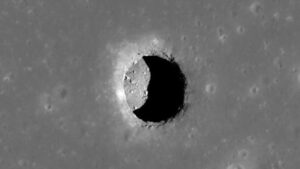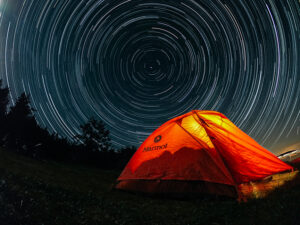While researching the Boötes Void, I came across the intriguing image below. This is what a void in space should look like, right? No stars, galaxies, or light of any kind? Just blank empty space. It even looks a bit like a boot!
Google Images and click-bait videos on YouTube enjoy using this image to represent one of the largest voids in space. However, this could not be further from the truth. Voids in space are not as empty as you would think.

Molecular cloud and dark nebula called Barnard 68. Photo: ESO
This image is not a void, but a dark nebula or a molecular cloud which obscures the light of stars and planets. Somehow, misinformation has led many sources to suggest that this is Boötes Void. Rather, Boötes Void is a way more complex and mysterious phenomenon in our universe, one which scientists are still trying to understand.
Into the void, we go…
Star Trek: Voyager fans might remember an episode where the crew sailed into a cosmic void in the Delta Quadrant. Essentially, this desolate area contained nothing, and other trapped starships battled it out for survival. A real space void is somewhat less dramatic.
What is a void in space, exactly? In order to understand, we need to journey back to the beginning of time itself. When the universe was born 13.8 billion years ago, there was absolutely nothing except dark matter and gases such as lithium, hydrogen, and helium.
Everything was hot and dense until the Big Bang. Then galaxies, stars, nebulae, planets, and other fantastical cosmic phenomena we see today through our deep space telescopes came into being. However, there are areas of low density between all these things.
A void in space simply refers to a region in which there are very few galaxies. They are the empty spaces that exist between filaments (“walls” of galaxies) and/or larger structures like superclusters (enormous galaxy clusters millions of light-years wide).
The empty spaces, filaments, and superclusters create an uneven distribution that looks like a sort of web. Writer Paul Sutter of Space.com appropriately calls these empty regions, devoid of activity, the “true deserts of the cosmos.” These voids come in many sizes but can extend more than 500 million light-years across.
Discovery
Astronomer Richard Kirshner discovered the Boötes Void, sometimes called the Great Nothing, in 1981 during a redshift survey of space. This is a search for celestial objects that are moving away from us. The Boötes Void lies, logically enough, in the Boötes constellation. This constellation hosts the fourth-brightest star in the night sky, as well as the largest known structure in the universe, the Hercules-Corona Borealis Great Wall.
Despite its wealth of amazing objects, the Boötes constellation has this extremely vast void that measures 330 million light-years in diameter. It makes up an incredible 2% of the observable universe. Within it, Kirshner and his team only found one spiral galaxy, affectionately termed the universe’s “loneliest galaxy.” Subsequent astronomers found more, but only 60 galaxies have turned up in this void so far. The distance from one galaxy to another is approximately 10 million light-years.
Many people tend to believe that voids are completely empty and just consist of black space. This is false. If the Milky Way resided in the Boötes Void, our knowledge of other galaxies would have come to us much later, points out astronomer Greg Aldering. Very little would have surrounded us, and early telescopes would not have seen beyond.
What makes this void interesting is that a region like this should have at least 2,000 galaxies, not 60. Additionally, no one has a good answer for how these voids came to be.

A detailed map of superclusters and voids in between. Photo: Azcolvin429/Wikipedia Commons
Theories
Scientists mostly agree that voids are echoes of the Big Bang. They usually search for voids in the cosmic microwave background. This is a map of lingering radiation from the birth of the universe. Voids are synonymous with regions of colder temperatures. While we know when they began, we need to figure out the details of their formation.
Another promising hypothesis is that Boötes Void became so big when smaller voids merged. As the universe expanded, gravity pulled galaxies toward other large structures or galaxies. As they were drawn together, the spaces between them expanded. However, some scientists disagree about this when it comes to Boötes Void. They believe there was not enough time since the Big Bang for a void this big to form.
It all comes down to what is driving the universe to expand, and that is dark energy. Quantum mechanics will undoubtedly make your brain hurt, but we should at least have an idea of what it is. Dark energy is a substance that scientists are still trying to decode. They do know that it is responsible for pushing galaxies away from each other and expanding the universe. This mysterious energy makes up 68% of the universe.

Bootes Void. Photo: Wikipedia
Conclusion
Until we know how dark energy works, we may never truly know how the Boötes Void came to be. We need to better understand how and why these regions exist. Also, we still do not know how the small number of galaxies managed to stay in these desolate regions rather than get pulled outward. Until we figure out how the universe began, we are left drifting in the ether.






